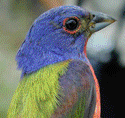Hue
From Wikipedia, the free encyclopedia

Hue is one of the main properties of a color described with names such as "red", "yellow", etc. The two other main properties are lightness and colorfulness. Hue is also one of the three dimensions in some colorspaces along with saturation, and lightness.
Usually, colors with the same hue are distinguished with adjectives referring to their lightness and/or chroma, such as with "light blue", "pastel blue", "vivid blue". Exceptions include brown, which is a dark orange,[1] and pink, a light red with reduced chroma.
In painting color theory, a hue refers to a pure color—one without tint or shade (added white or black pigment, respectively).[citation needed] A hue is an element of the color wheel.
Contents |
[edit] Computing hue
In opponent color spaces in which two of the axes are perceptually orthogonal to lightness, such as CIE L*a*b* (CIELAB) and CIE L*u*v* (CIELUV), hue may be computed together with chroma by converting these coordinates from rectangular form to polar form. Hue is the angular component of the polar representation, while chroma is the radial component.
Specifically, in CIELAB:[2]
while, analogously, in CIELUV:[2]
In practice, a four-quadrant arctangent may be used if available to invert these formulae.
[edit] Computing hue from RGB
Preucil[3] describes a color hexagon, similar to a trilinear plot described by Evans, Hanson, and Brewer,[4] which may be used to compute hue from RGB. To place red at 0°, green at 120°, and blue at 240°, one may solve:
He also used a polar plot, which he termed a color circle.[3] Using R, G, and B, rather than the R, G, and B densities Preucil used, one may compute hue angle using the following scheme: determine which of the six possible orderings of R, G, and B prevail, then apply the appropriate formula; see table below.
| Ordering | Hue Region | Formula |
|---|---|---|
 |
Red-Yellow |  |
 |
Yellow-Green |  |
 |
Green-Cyan |  |
 |
Cyan-Blue |  |
 |
Blue-Magenta |  |
 |
Magenta-Red |  |
Note that in each case the formula contains the fraction  , where H is the highest of R, G, and B; L is the lowest, and M is the mid one between the other two. This is referred to as the Preucil Hue Error, and was used in the computation of mask strength in photomechanical color reproduction.[5]
, where H is the highest of R, G, and B; L is the lowest, and M is the mid one between the other two. This is referred to as the Preucil Hue Error, and was used in the computation of mask strength in photomechanical color reproduction.[5]
Hue angles computed for the Preucil circle agree with the hue angle computed for the Preucil Hexagon at integer multiples of 30 degrees (red, yellow, green, cyan, blue, magenta, and the colors mid-way between contiguous pairs), and differ by approximately 1.2 degrees at odd integer multiples of 15 degrees (based on the circle formula), the maximum divergence between the two.
The process of converting an RGB color into an HSL color space or HSV color space is usually based on a 6-piece piecewise mapping, treating the HSV cone as a hexacone, or the HSL double cone as a double hexacone.[6] The formulae used are those in the table above.
[edit] Specialized hues
The hues exhibited by caramel colorings and beers are fairly limited in range. The Linner hue index is used to quantify the hue of such products.
[edit] Hue as a qualification in the names of artist's colors
Manufacturers of pigments use the word hue e.g. 'Cadmium Yellow (hue)' to indicate that the original pigmentation ingredient, often toxic, has been replaced by safer (or cheaper) alternatives whilst retaining the hue of the original. Replacements are often used for chromium, cadmium and alizarin.
[edit] Hue vs. dominant wavelength
Dominant wavelength (or sometimes equivalent wavelength) is a physical analog to the perceptual attribute hue. On a chromaticity diagram, a line is drawn from a white point through the coordinates of the color in question, until it intersects the spectral locus. The wavelength at which the line intersects the spectrum locus is identified as the color's dominant wavelength if the point is on the same side of the white point as the spectral locus, and as the color's complementary wavelength if the point is on the opposite side.[7]
[edit] Hue difference: Δh or ΔH * ?
There are two main ways in which hue difference is quantified. The first is the simple difference between the two hue angles. The symbol for this expression of hue difference is Δhab in CIELAB and Δhuv in CIELUV. The other is computed as the residual total color difference after Lightness and Chroma differences have been accounted for; its symbol is  in CIELAB and
in CIELAB and  in CIELUV.
in CIELUV.
[edit] See also
[edit] References
- ^ C J Bartleson, "Brown". Color Research and Application, 1 : 4, p 181-191 (1976).
- ^ a b Colorimetry, second edition: CIE Publication 15.2. Vienna: Bureau Central of the CIE, 1986.
- ^ a b Frank Preucil, "Color Hue and Ink Transfer … Their Relation to Perfect Reproduction, TAGA Proceedings, p 102-110 (1953).
- ^ Ralph Merrill Evans, W T Hanson, and W Lyle Brewer, Principles of Color Photography. New York: Wiley, 1953
- ^ Miles Southworth, Color Separation Techniques, second edition. Livonia, New York: Graphic Arts Publishing, 1979
- ^ Max K. Agoston (2004). Computer Graphics and Geometric Modelling v. 1: Implementation and Algorithms. Springer. pp. 301–304. ISBN 1852338180. http://books.google.com/books?visbn=1852338180&id=fGX8yC-4vXUC&pg=PA301&lpg=PA301&ots=w8cDX3NhWs&dq=hsv++hue+rgb&sig=apoei-VxRxFVMLXedUukOW5OZYE#PPA304,M1.
- ^ Deane B Judd and Günter Wyszecki, Color in Business, Science, and Industry. New York: Wiley, 1976.








